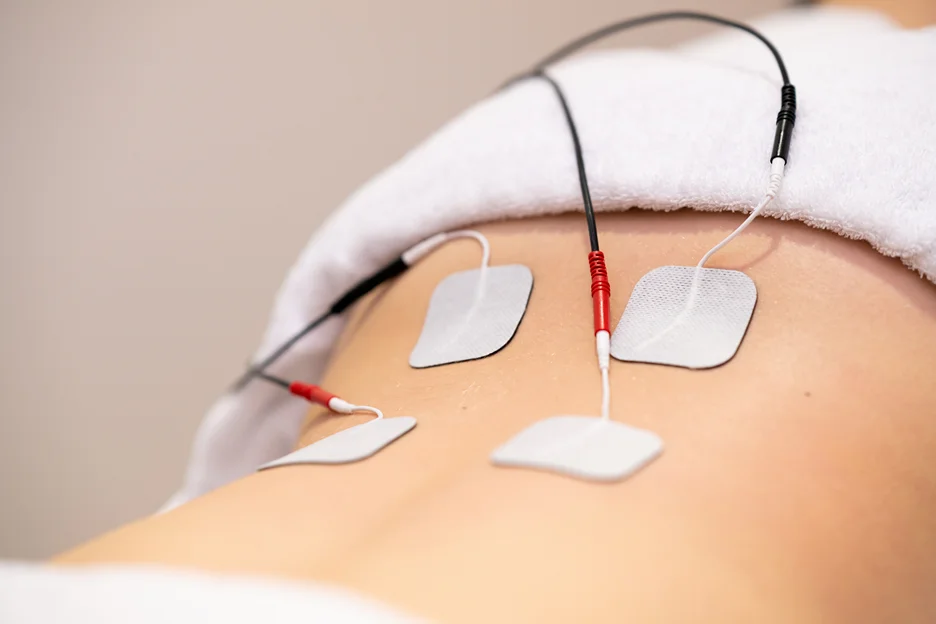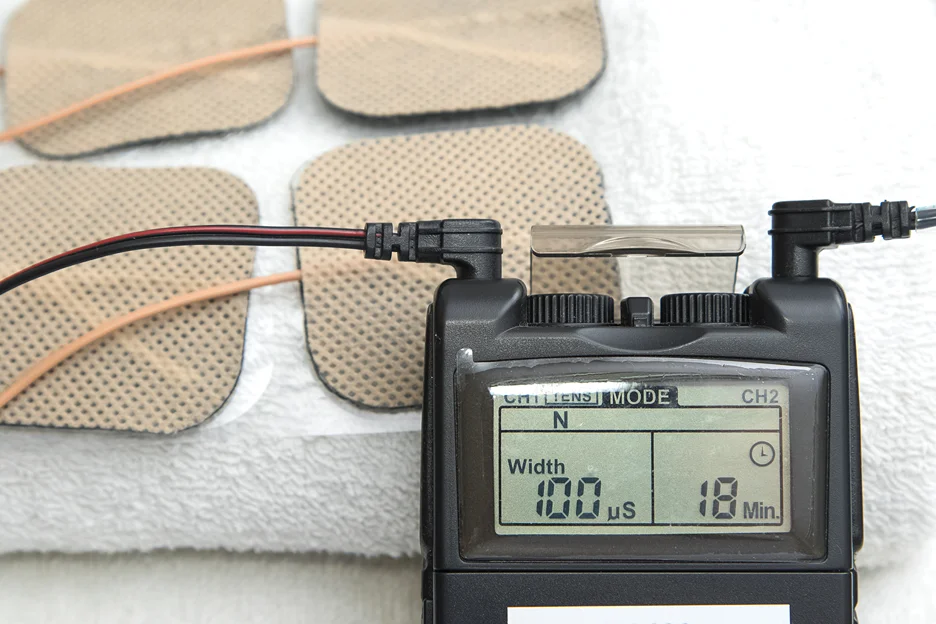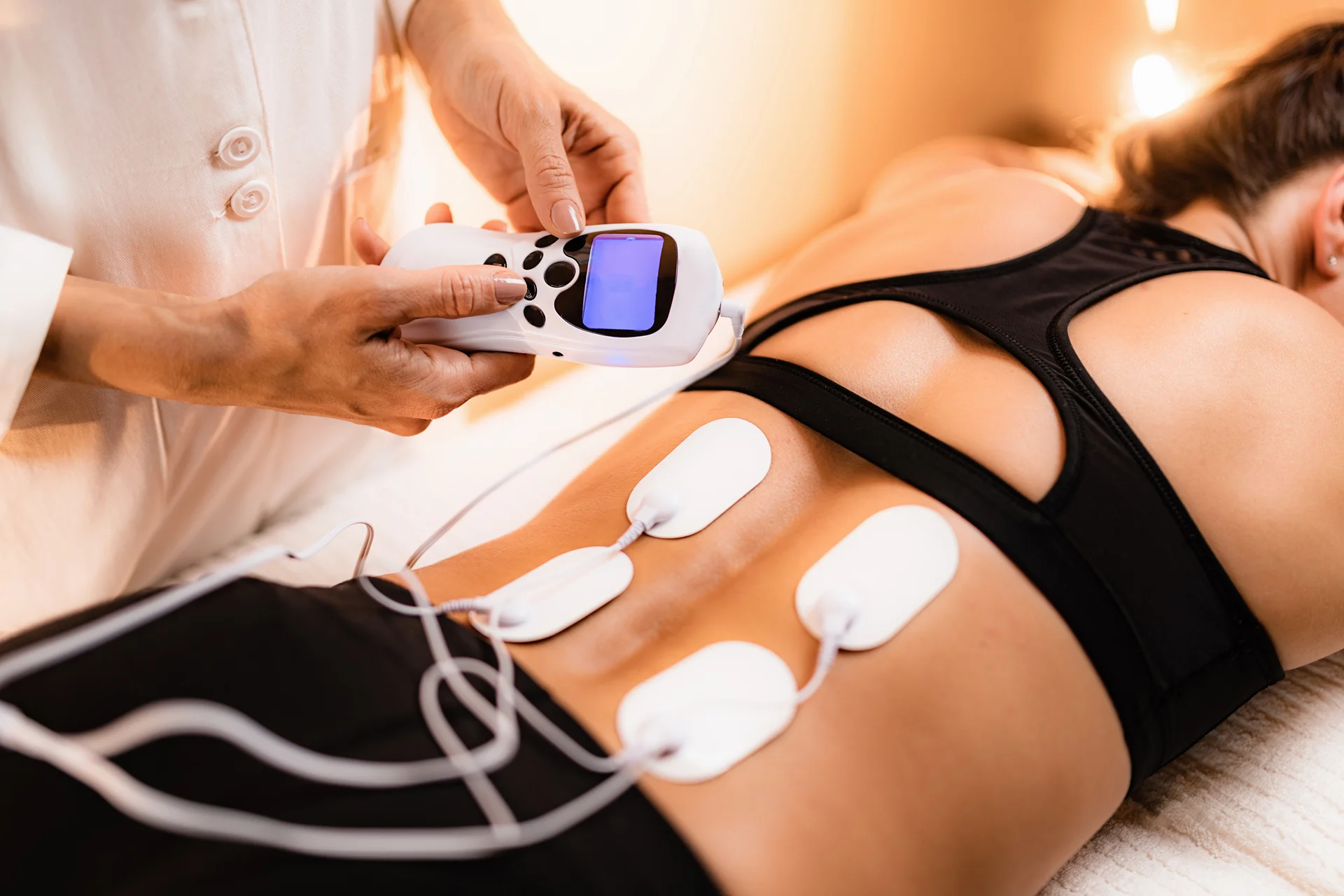Living with chronic back pain can feel crippling. Your quality of life suffers when every movement causes discomfort or pain. Is there no way out of this cycle other than popping pills regularly?
Well, the good news is there’s one option that’s growing in popularity called a transcutaneous electrical nerve stimulation (TENS) unit. Technically, these units give you drug-free back pain relief without any kind of invasive poking and prodding.
Sounds too good to be true? Stick with us to learn exactly how TENS stops pain, how it can help specifically with back pain, tips for using it best, and what to look for in choosing a unit.
What is a TENS Unit and How Does it Work?
A TENS (transcutaneous electrical nerve stimulation) unit is a battery-powered device that uses electrical impulses to relieve acute and chronic pain.
TENS units work by delivering small electrical currents to the skin via electrodes or adhesive pads placed near the source of pain. The electrodes transmit the electrical impulses through the skin to the underlying nerves.
The stimulation from the electrical current can interrupt the transmission of pain signals to the brain. It does this by stimulating the production of endorphins, which are the body’s natural pain-relieving chemicals.
TENS therapy has been used since the 1960s but did not gain widespread clinical use until the 1970s and 1980s. It is recommended for pain management by some doctors, physical therapists, and chiropractors.
What’s even greater is these portable devices let you give yourself pain relief treatments right in your own home. Users can control features like the intensity, pulse rate, and duration of treatment.
Still, appropriate TENS unit settings and electrode placement require training by a healthcare professional for optimal results
What Are the Potential Benefits of Using a TENS Unit for Back Pain?

Studies show TENS therapy can help all sorts of back pain – lower, upper, and even with spinal conditions – though the evidence is a bit mixed on how well it works across the board.
- Pain reduction – Multiple studies have found that TENS decreases self-reported pain levels in many back pain patients, compared to sham TENS, during or immediately after treatment.
- Improved physical function – Some studies have found improved mobility and ability to perform daily tasks when using TENS for chronic back pain, compared to control groups.
- Muscle relaxation – TENS may stimulate muscle relaxation through the electrical pulses, while also promoting circulation.
- Less medication use – Some patients report using less pain medication when adding TENS to their pain management regimen.
- Convenience and safety – TENS units allow at-home use with little risk of side effects. However, effectiveness and appropriate use should always be evaluated by a healthcare provider.
- Quality of life – Due to potential temporary pain relief and increased mobility, some back pain patients report better quality of life with TENS therapy added to their treatment plan.
What are the Recommended Settings and Usage Guidelines for a TENS Unit?
Following the proper protocols for using your TENS unit is important for getting optimal pain relief results. Here are some best practice tips for TENS usage for back pain:
Electrode placement
For lower back pain, place two electrodes on either side of the spine near where it hurts. Position the other two electrodes in line horizontally just above the waistband.
For upper back pain between the shoulder blades, place electrodes vertically along both sides of the spine. Adjust positioning to target painful trigger points.
Intensity
Start low and gradually increase intensity to just below the threshold of muscle contraction or discomfort. A tingling or buzzing sensation should be felt. Avoid intense settings that cause pain or visible muscle twitching.
Duration
Use TENS therapy in multiple short sessions of 20-30 minutes rather than one prolonged session. Try a 30-minute session, followed by a rest period to avoid over-stimulating nerves. Then do another 30-minute session if needed.
Frequency
Experts recommend using a TENS unit to manage chronic back pain 2-3 times per day for best results. Allow approximately 4 hours between sessions and alternate placement locations.
Safety precautions
Do not use a TENS unit if you have a pacemaker or implanted defibrillator. Consult your physician before using if pregnant, have cancer, or have skin conditions. Never place electrodes near the heart, brain, eyes, mouth, or front of the throat.
Ultimately, TENS should be considered an adjunct treatment and used under medical guidance.
What Should You Look for in Choosing a TENS Unit for Back Pain?

With so many TENS unit brands and models on the market, it can be tricky to discern which device may work best for your individual back pain needs. Here are the key features and factors to consider in your TENS unit selection:
- FDA approved – Only use TENS devices cleared for patient use by the U.S. Food and Drug Administration. This ensures your unit meets safety testing standards. Models like the Livia and Quell devices have FDA approval.
- The number of channels – Models with 4 channels or more allow you to connect multiple electrode pads and stimulate different areas simultaneously. This provides more targeted pain relief.
- Adjustable intensity levels – Choose a unit that allows you to customize and control the intensity of the electrical pulses. Having 20 intensity settings or more gives a greater ability to tailor the stimulation.
- Multiple modes – Look for a device with options for different pulse patterns, like burst, modulation, or acupuncture-like. Varying the mode prevents nerve adaptation.
- Customizable programs – Preset and customizable programs for pain locations allow you to save and quickly access optimal TENS settings.
- Digital display – An easy-to-read digital interface makes it simpler to monitor and adjust intensity, mode, and timer settings.
- Battery life – Rechargeable lithium polymer batteries last longer and are more cost-effective than disposable batteries.
- Warranty – Select a brand like TENS 7000 or iReliev that offers at least a 1 year manufacturer’s warranty for peace of mind with your investment.
- Medical recommendations – Consult your doctor or physical therapist for TENS unit brand and model recommendations based on your back pain symptoms.
- Cost – Prices range widely from $30 to $150 – but more sophisticated units can push that up to $500 or more.
Proper Placement of Electrodes
The placement of the electrode pads is key for getting the best pain relief results from your TENS unit. Here are some tips and strategies for positioning the electrodes effectively:
- For lower back pain, place two electrodes around the site of pain. Then position the other two pads horizontally above the waistband in line with the first pair.
- If pain is concentrated on one side, place the electrodes vertically surrounding the localized area to better target it.
- For upper back or neck pain, locate trigger points and sore spots then position electrodes vertically along both sides of the spine near those areas.
- Ensure there is some space between electrodes to allow the current to flow adequately. They work best 1-2 inches apart.
- Use medical-grade conductive gel on the electrodes and massage it into the skin to facilitate good electrical contact. Reapply gel regularly.
- Move the electrodes around to determine the placements that give maximum comfort based on your pain patterns. Note effective arrangements to reuse.
- Avoid bony areas and any body parts with impaired sensation for best results and to prevent skin irritation.
- For acute pain flares, try surrounding the most painful zone to help calm the irritated nerves.
Experiment with different electrode positions at various intensities to determine your optimal set-up.
Maximizing Pain Relief Through Correct TENS Settings
Getting the most out of your TENS therapy requires finding the right settings and protocols for your individual back pain. Here are some recommendations:
| Setting | Recommendations |
| Pulse Rate | Start at 70-100 Hz. Experiment between 70-150 Hz to find optimal rate. |
| Intensity | Begin lower and slowly increase just below muscular contraction or discomfort. Find your personal “sweet spot”. |
| Duration | Use for 20-30 minute sessions then take a short break. Can repeat sessions for added benefit. |
| Patterns | Alternate between continuous, burst, and modulated modes. Changing patterns prevents nerve adaptation. |
| Body Feedback | Adjust settings based on your pain relief response. |
| Consistency | Use consistent electrode placement and your noted best settings to condition nerves over time. |
| Periodic Adjustments | Increase intensity or change modes if effects begin diminishing. Prevents plateau |
With experience, you will learn how your body responds best. Optimal settings provide pain relief while avoiding muscle contractions.
Risks and Precautions When Using TENS Units
While TENS therapy is generally safe when used correctly, there are some risks and precautions to keep in mind:
- Do not use a TENS unit if you have a pacemaker, implanted defibrillator, or other internal electronic device, as the electrical current can interfere with these.
- Use caution if pregnant, as the effects on a developing fetus are not fully known. Seek medical guidance first.
- Avoid placing electrodes near the head, eyes, mouth, front of the throat, or directly over the heart which could cause unsafe stimulation.
- Skin irritation, burns, or blisters can occur if the intensity is too high or electrodes are left in the same spot too long.
- Headaches, muscle twitching, and worsened pain have been reported in some cases when TENS is overused or at very high intensities.
- Nerves can adapt to electrical stimulation over time, making it less effective. Avoid excessive use and allow time between sessions.
- Ensure electrodes are securely adhered and make good skin contact before turning on the device to prevent errant electrical pulses.
Work With Your Doctor to Find the Ideal TENS Settings for You

Always consult with your doctor first about any pre-existing conditions, risks given your health history, and guidance on proper TENS use.
Allow time to determine ideal settings that provide therapeutic benefits without side effects. Pay close attention to your body’s response and decrease intensity or stop use if any worrisome reaction occurs.
By considering these key factors and recommendations, you can find the ideal TENS unit to start experiencing the pain-relieving benefits of electrotherapy for your back.
Get more tips from doctors or connect with a physical therapist through Kaly’s telemedicine platform for personalized treatment recommendations. Invest in yourself by exploring safe, proven approaches to improve your back health.
